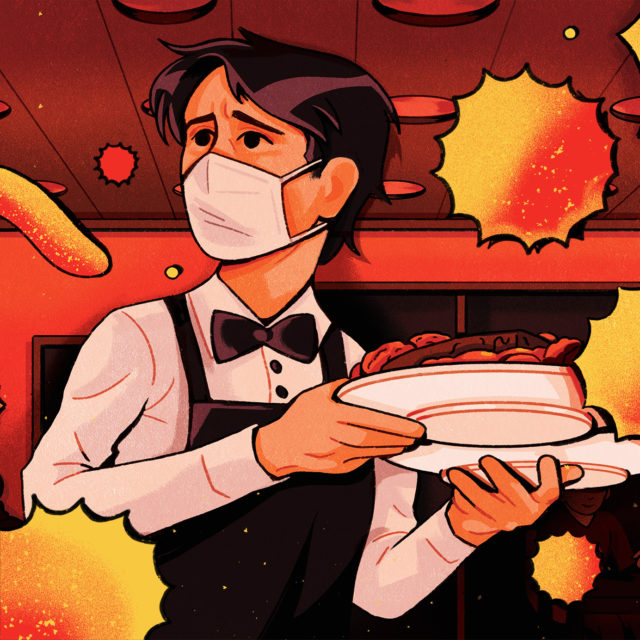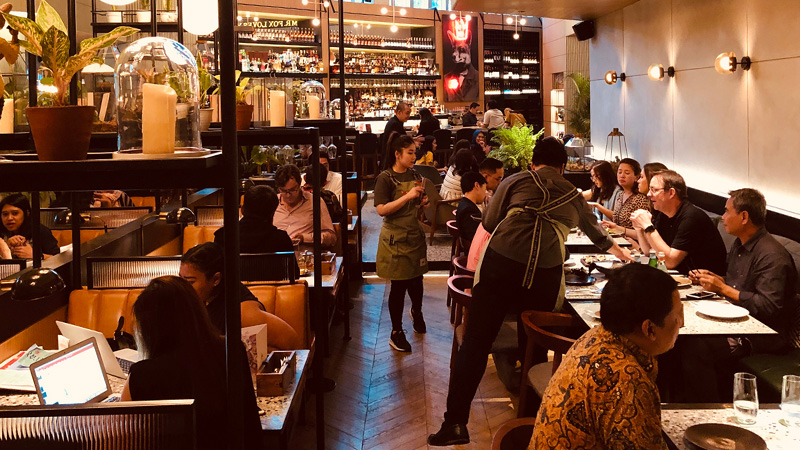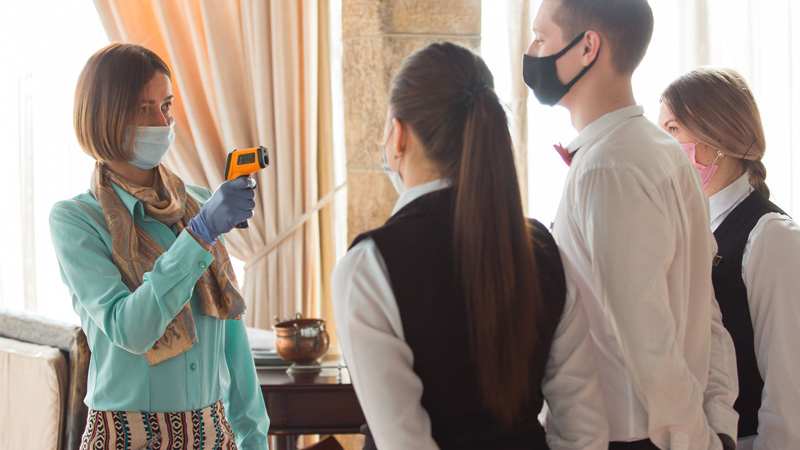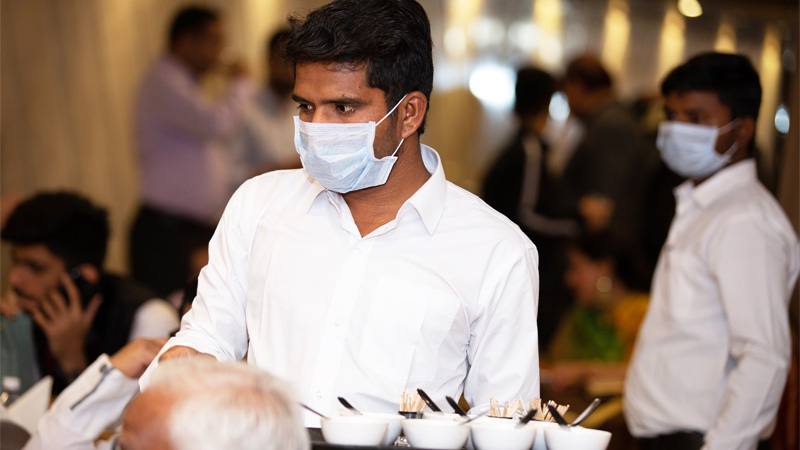Last week, Gov. Andrew Cuomo announced the return of indoor dining at 25 percent capacity in New York City. Effective Feb. 14, the plans hope to usher in the Valentine’s Day dinner dates that help so many NYC restaurants through the winter each year. But for the city’s hundreds of thousands of restaurant workers, the return to indoor dining may be met with apprehension as well as relief.
There is the distinct feeling lately that the survival of New York’s independent restaurants relies on the patronage of neighbors and regulars with good intentions and deep pockets.
However, with the dangers of Covid-19 looming in every poorly ventilated sidewalk greenhouse/dining room, many would-be diners are unwilling to brave the winter chill along with the risk of viral exposure.
When indoor dining was still permitted in the state (at 25 percent capacity, from Sept. 30 to mid-December), those who wanted to support their locals were then faced with a different choice: order food and drinks to go or to deliver, or dine cozily inside with mostly unmasked strangers.
What’s a hungry and charitable soul to do? For many, even when the infection rates of the pandemic kept climbing, indoor dining seemed safe enough — with staff masked, seating spaced out, and ventilation prioritized like never before. Enjoying a few drinks or a meal could feasibly be wrapped up in two hours or less for those who were wary of spending too much time inside, and many reservations were slotted to ensure less exposure for everyone. But what about the people making the drinks, preparing the food, and checking on the tables? Were they appreciative of the efforts of those who chose to spend their money on an indoor meal?
Until March 2020, when I was laid off due to Covid, I worked consistently in bars in this city for well over a decade. Though this experience gives me my own opinions on the current landscape of my industry, I lack the perspective of someone who puts themselves into the thick of it on a daily basis during a global pandemic. That’s why, late last year, I reached out to a few of my fellow hospitality workers and asked for their insights as they faced indoor dining at their jobs the first time around. Their stories might help us now, as we prepare to give indoor dining another try.
[Editor’s note: This story was originally reported in December 2020. It has been updated to reflect indoor dining closing Dec. 14, 2020, and re-opening Feb. 14, 2021.]
It’s Going ‘Well’
Bar and restaurant professionals tend to be optimists out of necessity. It’s a healthier way to survive what can be notoriously soul-crushing work. So when I asked how guests were behaving indoors with fairly new safety protocols, my sources’ responses were generally, unsurprisingly, similar: They put on a brave face and insisted that indoor diners were actually doing pretty well.
At one Union Square establishment, measures such as temperature checks at the door and the collection of contact information were in place, but masks were required only while guests were not seated. This rule left the masked-up staff reminding people to put face coverings back on every time they got up to use the restroom. The guests were overall amenable, according to head bartender Hannah McClendon. “The problem is,” she says, “they get drunk.”
Ah yes, the thrill of the job — a thrill most often acquired by talking down an inebriated customer from annoying their fellow patrons, potentially breaking glassware, or blowing up in anger at being cut off — had transformed into a viral patrol.
On the Lower East Side, indoor diners at one restaurant were encouraged to keep masks on if staff approached their tables. Bar manager Sarah Morrissey says she told guests, “If you can’t put your mask on, then just put your napkin over your face.” But the difficulty lay not in the patrons’ understandable forgetfulness. “People do forget,” she says, “but nobody would listen [in the first place].”
Seemingly obvious precautions, such as holding doors open to promote air flow and keep droplets moving away from guests, were sometimes met with derision. “We have tons of doors so we would keep them open with the heat blasting, and people would be like, ‘Can you close the doors?’ on a not-that-cold night. And we were like, ‘no,’” Morrissey says with a laugh, “’it’s called cross ventilation, bro.’”
In addition to temperature checks and hand sanitizing at the door, one roomy restaurant in the Financial District has high ceilings that offer a view of even more space and ventilation. This visual, coupled with the ownership of a pricey AtmosAir bipolar ionization system, certainly set guests at ease. “It is like a Band-Aid on a bullet wound, but it’s something,” says Ashley B. (she asked us not to use her full name), the restaurant’s hospitality manager. “And it comforts people.” Ashley believes the atmosphere is one of the reasons the restaurant has such a steady flow of business, but she noticed that other safety measures made guests nervous. When taking down information for contact tracing, many were hesitant to give out their addresses. “They think I want to send them marketing materials, but we don’t have money to buy a stamp to send you a flyer about our business,” she half-jokes.
Ashley admits that she didn’t notice much noncompliance, but adds that there was still confusion about government-mandated requirements. “It’s weird seeing that people really don’t know the rules,” she says, referring to the fact that guests didn’t like leaving behind addresses, had trouble departing by earlier closing times, and still attempted to approach the bar for service when such a thing had been verboten since restaurants first reopened over the summer. “The travelers get really irate. ‘I forgot we’re in New York.’ … That’s a struggle,” she says. “We’re doing our damned best.”
When Busy Isn’t Better
Restaurants and bars are closing every day, unable to make rent with limited seating capacities and stubborn, sometimes heartless landlords. Seeing once-packed happy-hour spots suddenly barren is chilling, but a teeming bar will have poor optics of its own these days. McClendon was fortunate enough to be able to transfer to her company’s Union Square location after a Midtown closure. “This place is popping … to the point where I’m starting to feel kind of unsafe,” she admits. Even with indoor dining capacity restrictions, sometimes the room could seem overly crowded by pandemic standards. “It’s a small place and apparently our [25 percent] capacity is 50 people,” McClendon calculates, “but I’m pretty sure it’s over 50 people there all night.”
In any case, guests often took the environment for granted and began to feel too comfortable. “There is this weird mentality that once people are at their table, they’re safe,” she says. As a result, masks were rarely up, and often easily forgotten. This became an issue at a Brooklyn bar where she previously worked; about one interaction there, McClendon says incredulously, “I had to refuse service to someone who would not put their mask on.” In other words, she felt her safety was of no concern to a person who demanded drinks.
Redefining ‘Well’
The only way for staff to keep safe and sane while combating the daily ignorances of guests is to be steadfast, patient, and lighthearted in a truly depressing situation. Without a government bailout for restaurants, all these professionals can do is make the best of it and take all the possible precautions.
Serving New Yorkers (and tourists, although there aren’t many of those about these days) is always a lesson in futility: If one witnesses a bartender pausing to explain how the sliding bathroom door works to a single patron during their visit, rest assured that bartender is explaining it to 10 or 20 more throughout the course of a shift. Now imagine if every eighth person who didn’t know how to operate a door also had been exposed unknowingly to a deadly virus, and perhaps the exasperation that one reads on their server’s face becomes more understandable. “But, it’s so nice to have a job,” McClendon chipperly insists, heartbreakingly earnest, because the fact is that most people in our industry no longer do.
“This whole thing has made you rethink what ‘well’ means. There are people here and they are dining. Of course there could be more, but I think we aren’t hurting as much as other people,” Ashley says of her restaurant, acknowledging that being able to make money during this crisis is rare. “But doing well for our business [in this situation] means it’s at a much higher risk for our health. So yeah, it’s tough.” That heightened risk is quite real, as she tells me that the restaurant had just reopened after a day-long closure to disinfect after a colleague became infected with Covid-19. Without an announcement regarding restaurant workers’ eligibility for the vaccine to this deadly virus, it seems the threat to their health will continue once again with a return to indoor dining on Feb. 14.
“It’s so weird. I’m really concerned,” says McClendon. Indoor dining was progressing at the bustling bar, while the virus continued to rise.
For smaller operations, like the one on the Lower East Side, it was just “weird” enough for the restaurant to cease seating indoor tables of its own volition right before Thanksgiving. “We stopped it because no one wanted to listen to our rules. We might revisit it,” Morrissey says, explaining that having four tables inside, even adding a two-top from time to time, was too much of a headache in their small dining room. The extra profit on those seats was not worth it. “We just want our space back.”
How to Help
When an industry is left to its own devices, without aid or concern for its workers during a crisis of this magnitude, it understandably struggles to keep those within it both safe and paid. A recent study by One Fair Wage, which reports high risk of both Covid-19 infection and sexual harassment against restaurant workers, paints a much darker picture than the one that I was able to discern when conducting interviews. However, speaking to these hospitality professionals hinted at many of the issues reflected in the study.
Perhaps this is an uncomfortable topic for those who bar-hopped indiscriminately during pandemic times, or maybe it will serve as an affirmation for those who kept turning down invitations to hang out indoors despite peer pressure. No matter where one lands on the personal comfort spectrum, it is my hope that more people will realize that without federal aid, restaurants will continue to rely on staff working in dangerous conditions to make enough money to keep the doors open and the lights on. Instead, let’s support relief funds for affected workers and make our pleas for government assistance heard through organizations like the Independent Restaurant Coalition. We can also write to and call Congress to urge it to pass the Real Economic Support That Acknowledges Unique Restaurant Assistance Needed To Survive (RESTAURANTS) Act. The survival of our restaurants is on the line, and it is not on New York City diners to save them.
“Restaurant workers are in an impossible situation,” says John deBary, co-founder and board president of the Restaurant Workers’ Community Foundation, which has a Covid-19 emergency relief fund and provides resources for restaurant workers coping with the crisis. “Individual actions alone aren’t enough. We all need to do our part to create a society where workers are rightfully recognized for the vital role they play in our economy and culture.”
Now, at the time of publication, hospitality workers are not eligible for the Covid-19 vaccine despite the announcement of a possible Valentine’s Day reopening for indoor dining. I’ve contacted the governor, my senator, and my Assembly member to express concern because the staff of our bars and restaurants should be included in Phase 1b of the distribution of the vaccine as frontline essential workers so that they have the option to further protect themselves while they serve eager diners.
When indoor dining returns to New York City, I would love for the stories circulating among my industry comrades to change, and to become vastly more positive and convincingly optimistic. I do believe that there is a resurgence ahead for our bars and restaurants — as long as they can weather this bleak winter.
This story is a part of VP Pro, our free platform and newsletter for drinks industry professionals, covering wine, beer, liquor, and beyond. Sign up for VP Pro now!



